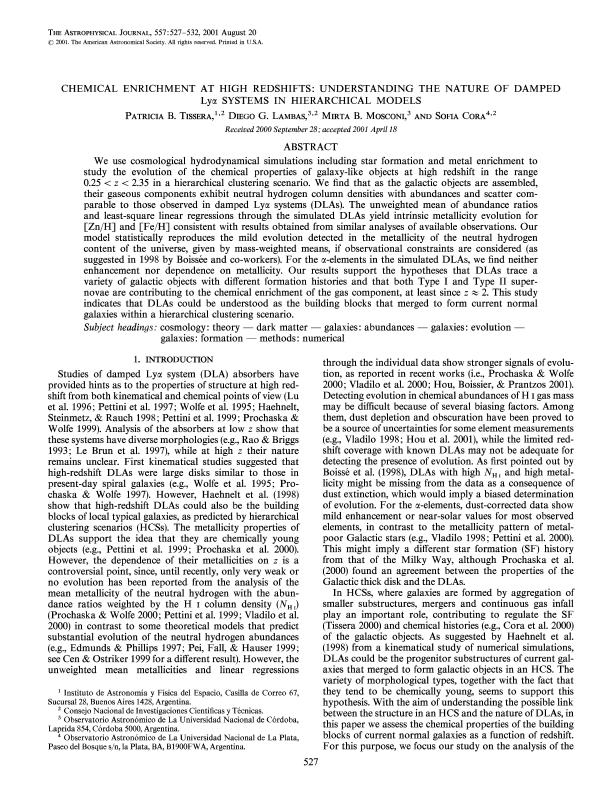Mostrar el registro sencillo del ítem
dc.contributor.author
Tissera, Patricia Beatriz

dc.contributor.author
Garcia Lambas, Diego Rodolfo

dc.contributor.author
Mosconi, Mirta B.
dc.contributor.author
Cora, Sofia Alejandra

dc.date.available
2017-08-15T17:41:19Z
dc.date.issued
2001-08
dc.identifier.citation
Tissera, Patricia Beatriz; Garcia Lambas, Diego Rodolfo; Mosconi, Mirta B.; Cora, Sofia Alejandra; Chemical Enrichment at High Redshifts: Understanding the Nature of Damped Lyα Systems in Hierarchical Models; IOP Publishing; Astrophysical Journal; 557; 2; 8-2001; 527-532
dc.identifier.issn
0004-637X
dc.identifier.uri
http://hdl.handle.net/11336/22485
dc.description.abstract
We use cosmological hydrodynamical simulations including star formation and metal enrichment to study the evolution of the chemical properties of galaxy-like objects at high redshift in the range 0.25 < z < 2.35 in a hierarchical clustering scenario. We find that as the galactic objects are assembled, their gaseous components exhibit neutral hydrogen column densities with abundances and scatter comparable to those observed in damped Lyα systems (DLAs). The unweighted mean of abundance ratios and least-square linear regressions through the simulated DLAs yield intrinsic metallicity evolution for [Zn/H] and [Fe/H] consistent with results obtained from similar analyses of available observations. Our model statistically reproduces the mild evolution detected in the metallicity of the neutral hydrogen content of the universe, given by mass-weighted means, if observational constraints are considered (as suggested in 1998 by Boissée and co-workers). For the α-elements in the simulated DLAs, we find neither enhancement nor dependence on metallicity. Our results support the hypotheses that DLAs trace a variety of galactic objects with different formation histories and that both Type I and Type II supernovae are contributing to the chemical enrichment of the gas component, at least since z ≈ 2. This study indicates that DLAs could be understood as the building blocks that merged to form current normal galaxies within a hierarchical clustering scenario.
dc.format
application/pdf
dc.language.iso
eng
dc.publisher
IOP Publishing

dc.rights
info:eu-repo/semantics/openAccess
dc.rights.uri
https://creativecommons.org/licenses/by-nc-sa/2.5/ar/
dc.subject
Cosmology
dc.subject
Dark Matter
dc.subject
Galaxies
dc.subject.classification
Astronomía

dc.subject.classification
Ciencias Físicas

dc.subject.classification
CIENCIAS NATURALES Y EXACTAS

dc.title
Chemical Enrichment at High Redshifts: Understanding the Nature of Damped Lyα Systems in Hierarchical Models
dc.type
info:eu-repo/semantics/article
dc.type
info:ar-repo/semantics/artículo
dc.type
info:eu-repo/semantics/publishedVersion
dc.date.updated
2017-08-14T19:51:27Z
dc.journal.volume
557
dc.journal.number
2
dc.journal.pagination
527-532
dc.journal.pais
Reino Unido

dc.journal.ciudad
Londres
dc.description.fil
Fil: Tissera, Patricia Beatriz. Consejo Nacional de Investigaciónes Científicas y Técnicas. Oficina de Coordinación Administrativa Ciudad Universitaria. Instituto de Astronomía y Física del Espacio. - Universidad de Buenos Aires. Facultad de Ciencias Exactas y Naturales. Instituto de Astronomía y Física del Espacio; Argentina
dc.description.fil
Fil: Garcia Lambas, Diego Rodolfo. Universidad Nacional de Cordoba. Observatorio Astronomico de Cordoba; Argentina. Consejo Nacional de Investigaciones Científicas y Técnicas; Argentina
dc.description.fil
Fil: Mosconi, Mirta B.. Universidad Nacional de Cordoba. Observatorio Astronomico de Cordoba; Argentina
dc.description.fil
Fil: Cora, Sofia Alejandra. Consejo Nacional de Investigaciones Científicas y Técnicas. Centro Científico Tecnológico Conicet - La Plata. Instituto de Astrofísica La Plata. Universidad Nacional de La Plata. Facultad de Ciencias Astronómicas y Geofísicas. Instituto de Astrofísica la Plata; Argentina
dc.journal.title
Astrophysical Journal

dc.relation.alternativeid
info:eu-repo/semantics/altIdentifier/url/http://iopscience.iop.org/article/10.1086/321672
dc.relation.alternativeid
info:eu-repo/semantics/altIdentifier/doi/http://dx.doi.org/10.1086/321672
Archivos asociados
